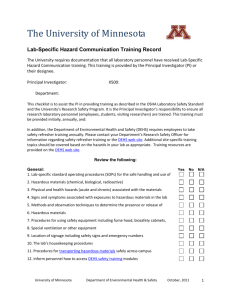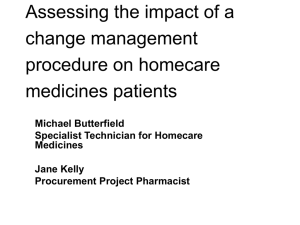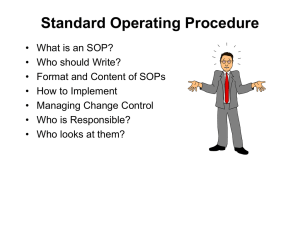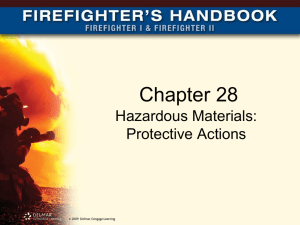Equipment service - World Health Organization
advertisement
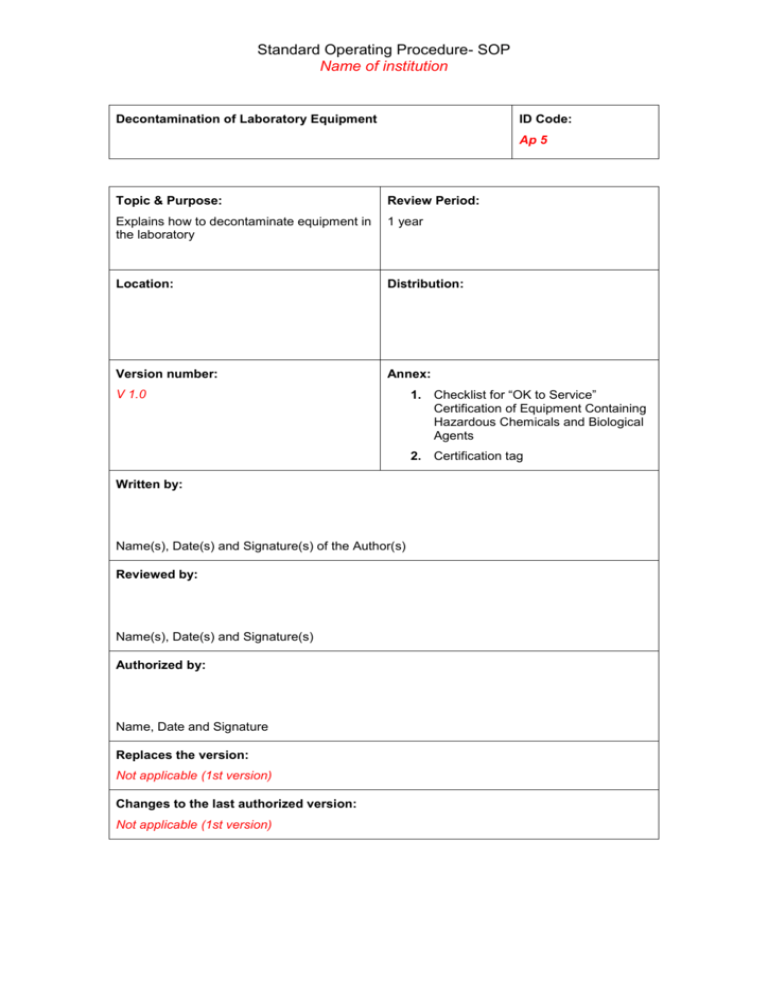
Standard Operating Procedure- SOP Name of institution Decontamination of Laboratory Equipment ID Code: Ap 5 Topic & Purpose: Review Period: Explains how to decontaminate equipment in the laboratory 1 year Location: Distribution: Version number: Annex: V 1.0 1. Checklist for “OK to Service” Certification of Equipment Containing Hazardous Chemicals and Biological Agents 2. Certification tag Written by: Name(s), Date(s) and Signature(s) of the Author(s) Reviewed by: Name(s), Date(s) and Signature(s) Authorized by: Name, Date and Signature Replaces the version: Not applicable (1st version) Changes to the last authorized version: Not applicable (1st version) Institution: Version: 1.0 Date: Number of pages: Name of 8 procedure: Decontamination of Laboratory Equipment Procedure ID Code: Ap 5 QM chapter: 5 Decontamination of Laboratory Equipment Procedure Application ....................................................................................................... 2 Objective .......................................................................................................... 2 Definitions ........................................................................................................ 2 References....................................................................................................... 2 Responsibilities ................................................................................................ 2 Operating mode ............................................................................................... 2 Material removal ........................................................................................... 3 Radiological residues ................................................................................ 3 Chemical residues .................................................................................... 3 Bio-hazardous contaminants .................................................................... 3 Certification and labelling ............................................................................. 4 Equipment service ........................................................................................ 4 Biosafety consideration ................................................................................ 4 Related documents .......................................................................................... 5 Annex 1 ............................................................................................................ 6 Annex 2 ............................................................................................................ 8 Application This procedure ensures decontamination of laboratory equipment. Objective This procedure explains the measures to be followed to safely and properly decontaminate laboratory equipment prior to service or repair by Facilities Operations or commercial service vendors. Adherence to this procedure will ensure that service employees are not needlessly exposed to potentially hazardous materials and that no materials are inappropriately released to the environment. Definitions To be filled in if necessary References To be filled in if necessary Responsibilities To be defined Operating mode Any unusual problems must be referred to the Biosafety Officer, who will assist in managing unusual or special problems, and will authorize any necessary deviations from this procedure. The Biosafety Officer will not authorize equipment repair or other service until the equipment has been cleared as outlined in this procedure. 22 Institution: Version: 1.0 Date: Number of pages: Name of 8 procedure: Decontamination of Laboratory Equipment Procedure ID Code: Ap 5 QM chapter: 5 A copy of this procedure will be provided to commercial service vendors and Facilities Operations staff prior to any service or repair of equipment. Staff and students will follow this procedure, and will refer any problems or questions to their supervisor. Material removal Before servicing or repair of equipment, laboratory personnel will completely remove all hazardous chemical, radiological, or bio-hazardous materials from the equipment, then either store or dispose the materials, as appropriate. In some instances, it may be appropriate to decontaminate only part of the equipment, in consideration of the nature of the service to be performed and the equipment surfaces with which workers are expected to come into contact. In this case, materials may remain within the equipment if there will be no direct contact with the materials in the course of servicing the equipment. It is strongly recommended that service workers and laboratory personnel discuss in advance the proposed service in order to mutually determine the required level of decontamination. Radiological residues If radiological substances are used in the laboratory, potential radiological residues should be addressed. Chemical residues Chemical residues will be removed, neutralized, or otherwise rendered nonhazardous using an appropriate method determined by the chemical and physical characteristics of the contaminant(s), and the physical nature of the equipment (refer to SOP Use of Hazardous Chemicals or Physical Hazards). Hazard labels shall be removed, defaced, or temporarily covered as appropriate. The decontamination method shall be documented, and records shall be available for inspection by the Biosafety Officer. Any incidental wastes shall be disposed of properly according to the SOP Waste Disposal. Bio-hazardous contaminants Bio-hazardous contaminants shall be removed or rendered nonpathological. This will typically be accomplished using a bleach solution or other chemical means (refer to SOP Disinfection and Chemical Cold Sterilization) or by steam sterilization (refer to SOP Sterilization by Wet Heat). 33 Institution: Version: 1.0 Date: Number of pages: Name of 8 procedure: Decontamination of Laboratory Equipment Procedure ID Code: Ap 5 QM chapter: 5 Hazard labels shall be removed, defaced or temporarily covered as appropriate. The decontamination method shall be documented and records made available for inspection by the Biosafety Officer. Any incidental wastes shall be disposed of properly according to SOP Waste Disposal. The “Checklist for ‘OK to Service’ Certification of Equipment Containing Hazardous Chemicals and Biological Agents” (Annex 1) shall be implemented. If decontamination cannot be achieved, it may be appropriate instead to cover the contaminated surfaces with impermeable materials such as polyethylene sheets. Any contamination, which has been temporarily covered over, must be clearly labelled and explained to service personnel before work begins. After servicing is completed, the covering material shall be disposed of as appropriate for the contaminant hazard. No decontamination is required for equipment within laboratories that has no potential for contamination, such as computers, office equipment, audio-visual equipment, cameras, optical equipment, refrigerators, etc. Certification and labelling Once material removal and decontamination have been completed, the Biosafety Officer (or other authorized individual as designated in writing) shall affix an “OK to Service” certification tag to the equipment (see Annex 2). All sections of the tag shall be completed with the relevant information or “NA” (non applicable) as appropriate. A copy of the tag will be retained, and shall be available for inspection. The original should be kept for the laboratory’s records and a second copy should be sent to the Biosafety Committee. For equipment with no potential for contamination, the “No Potential for Contamination” box shall be checked on the “OK to Service” tag. In addition, the name and date section should be completed, while the other sections may be left blank. Equipment service Once the “OK to Service” tag has been affixed to the equipment, it may be serviced. Facilities Operations will not service any equipment that has not been tagged. Laboratory personnel should be readily available to answer questions, and should explain any special considerations to service personnel. Biosafety consideration If a biosafety problem occurs, laboratory personnel will inform the Biosafety Officer, who will refer to SOP Minor Occurrence or SOP Major Occurrence 44 Institution: Version: 1.0 Date: Number of pages: Name of 8 procedure: Decontamination of Laboratory Equipment Procedure ID Code: Ap 5 QM chapter: 5 and SOP Occurrence Report, and then, if needed, report the problem to the Biosafety Committee and find a solution. This will be recorded in the corresponding logbook XXX. Related documents SOP Disinfection and Chemical Cold Sterilization Ref XXX SOP Major Occurrence Ref XXX SOP Minor Occurrence Ref XXX SOP Occurrence Report Ref XXX SOP Sterilization by Wet Heat Ref XXX SOP Use of Hazardous Chemicals or Physical Hazards Ref XXX SOP Waste Disposal Ref XXX 55 Institution: Version: 1.0 Date: Number of pages: Name of 8 procedure: Decontamination of Laboratory Equipment Procedure ID Code: Ap 5 QM chapter: 5 Annex 1 Checklist for “OK to Service” Certification of Equipment Containing Hazardous Chemicals and Biological Agents All laboratory equipment to be serviced must be decontaminated prior to servicing. Please implement the checklist below to ensure the equipment is “OK to Service” safely. Plan enough time to perform all necessary decontamination procedures. a) Specify the service requested on the Equipment “OK to Service” Certification Form. b) Determine what area of the equipment needs to be accessed for servicing and which area(s) are restricted due to potential chemical, biological, or radiological contamination. c) If the service area(s) contain(s) hazardous chemicals or biological materials, determine what can be disposed of (check for items that might have significant chemical degradation). Process disposal paperwork and have wastes removed. Follow SOP Waste Disposal for biohazardous material. Remove and properly store any containers of hazardous materials that are to be saved. d) Decontaminate all area surfaces that the equipment repair worker may contact with appropriate chemical or physical methods that are known to remove, neutralize, or otherwise render non-hazardous to human health or the environment any hazardous chemicals (chemical residues, stains, deposits, etc.). Refer to SOP Use of Hazardous Chemicals or Physical Hazards. e) Decontaminate all area surfaces that the equipment repair worker may contact with appropriate solutions that are known to kill the organisms that may be present as well as inactivate any hazardous substances of biological origin. Refer to SOP Disinfection and Chemical Cold Sterilization. f) If decontaminating agents may leave a corrosive or otherwise harmful residue, the surfaces must be rinsed clean of hazardous deposits. g) Before certifying the equipment as “OK to Service”, do a thorough survey of the area(s) (internal and external surfaces, void spaces, etc.) to verify proper decontamination was performed. 66 Institution: Version: 1.0 Date: Number of pages: Name of 8 procedure: Decontamination of Laboratory Equipment Procedure ID Code: Ap 5 QM chapter: 5 h) Fill in the Equipment "OK to Service" Certification tag (see Annex 2). SPECIFY ON THE TAG THE DURATION FOR WHICH THE CERTIFICATION WILL REMAIN IN EFFECT (start and finish dates). i) Affix the Equipment “OK to Service” Certification tag, with area(s) that are “OK to Service” clearly stated, to the exterior of the equipment in a prominent location. This will certify that the equipment poses no hazard to human health or the environment. 77 Institution: Version: 1.0 Date: Number of pages: Name of 8 procedure: Decontamination of Laboratory Equipment Procedure ID Code: Ap 5 QM chapter: 5 Annex 2 Equipment "OK to Service" Certification Service requested: ______________________________________________ Dates certification is in effect: ____________ to ___________ [ ] This equipment has no potential for chemical, radiological, or bio-hazardous contamination because it has never been used for or in contact with such materials and is therefore "OK to Service" for unrestricted use. [ ] This equipment has been decontaminated in accordance with the "OK to Service" Checklist and is safe to service with the following restrictions or special conditions: ______________________________________________________________ ______________________________________________________________ ______________________________________________________________ [ ] This equipment has been decontaminated in accordance with the "OK to Service" Checklist and is safe to service. Item’s Description: Make / Model / Serial Number ______________________________________ Identification Number _______________________________________ Item's Current Location: Room / Building / Department _______________________________________ Item Responsible Person Name: ____________________________________ Phone: ____________________________________ Certification Statement I certify that the above named equipment is free to the limits specified above of any hazardous chemical, biological and radioactive materials and I attest that this equipment does not pose a hazard to human health or the environment to the limits specified above. Certified By: _________________________ _______________________ ____________ Print name Signature Date 88

